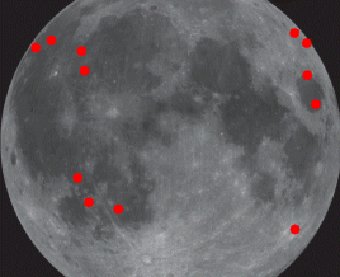
Publisher:
Bonnie King
CONTACT:
Newsroom@Salem-news.com
Advertising:
Adsales@Salem-news.com

~Truth~
~Justice~
~Peace~
TJP
Dec-01-2006 20:16

 TweetFollow @OregonNews
TweetFollow @OregonNews
Lunar Leonid Strikes
Dr. Tony Phillips Science@NASAMeteoroids are smashing into the Moon a lot more often than anyone expected.
 Lunar Impacts - NASA.gov |
(NASA) - Meteoroids are smashing into the Moon a lot more often than anyone expected.
That's the tentative conclusion of Bill Cooke, head of NASA's Meteoroid Environment Office, after his team observed two Leonids hitting the Moon on Nov. 17, 2006. "We've now seen 11 and possibly 12 lunar impacts since we started monitoring the Moon one year ago," says Cooke. "That's about four times more hits than our computer models predicted."
If correct, this conclusion could influence planning for future moon missions. But first, the Leonids:
Last month, Earth passed through a "minefield" of debris from Comet 55P/Tempel-Tuttle. This happens every year in mid-November and results in the annual Leonid meteor shower. From Nov. 17th to Nov. 19th both Earth and the Moon were peppered with meteoroids.
Meteoroids that hit Earth disintegrate harmlessly (and beautifully) in the atmosphere. But the Moon has no atmosphere to protect it, so meteoroids don't stop in the sky. They hit the ground. The vast majority of these meteoroids are dust-sized, and their impacts are hardly felt. But bigger debris can gouge a crater in the lunar surface and explode in a flash of heat and light. Some flashes can be seen from Earth.
During the passage through Tempel-Tuttle's debris field, Cooke's team trained their telescopes (two 14-inch reflectors located at the Marshall Space Flight Center) on the dark surface of the Moon. On Nov. 17th, after less than four hours of watching, they video-recorded two impacts: a 9th magnitude flash in Oceanus Procellarum (the Ocean of Storms) and a brighter 8th magnitude flash in the lunar highlands near crater Gauss.
"The flashes we saw were caused by Leonid meteoroids 2 to 3 inches (5 to 8 cm) in diameter," says Cooke. "They hit with energies between 0.3 and 0.6 Giga-Joules." In plain language, that's 150 to 300 pounds of TNT.
How do you get so much energy out of a 3-inch meteoroid? "Leonids travel fast—about 144,000 mph," he explains. "At that speed, even a 3-inch rock packs tremendous energy."
For comparison, the ESA's SMART-1 probe crashed into the Moon on Sept. 2nd, delivering 0.6 Giga-Joules of energy to the lunar surface—the same as the brighter of the two Leonids.
"Leonid impacts are as energetic as the crash of a 700-lb spacecraft!" says Cooke.
With these latest detections, Cooke's group has tallied a dozen "lunar meteors" since Nov. 2005. Most were sporadic meteoroids--meaning they are part of no annual shower like the Leonids, but just random chips of asteroids and comets floating around in space. Cooke estimates that for every four hours they observe the Moon, they see one bright flash caused by the impact of a large meteoroid.
see captionAnd that's surprising. "Our best models of the lunar meteoroid environment predict a much lower rate—only 25% of what we are actually seeing." The problem may be with the computer models: "They're based on observations of meteors in the skies of Earth," and those data may not translate well to the Moon.
The solution? "We need to spend more time watching the Moon," says Cooke. "With more data, we can draw stronger conclusions about the impact rate."
NASA needs that kind of information to decide, e.g., if it's safe for astronauts to go moonwalking during a meteor shower; and to calculate the necessary thickness of shielding for lunar spacecraft and habitats.
Articles for November 30, 2006 | Articles for December 1, 2006 |

googlec507860f6901db00.html

Quick Links
DINING
Willamette UniversityGoudy Commons Cafe
Dine on the Queen
Willamette Queen Sternwheeler
MUST SEE SALEM
Oregon Capitol ToursCapitol History Gateway
Willamette River Ride
Willamette Queen Sternwheeler
Historic Home Tours:
Deepwood Museum
The Bush House
Gaiety Hollow Garden
AUCTIONS - APPRAISALS
Auction Masters & AppraisalsCONSTRUCTION SERVICES
Roofing and ContractingSheridan, Ore.
ONLINE SHOPPING
Special Occasion DressesAdvertise with Salem-News
Contact:AdSales@Salem-News.com


Terms of Service | Privacy Policy
All comments and messages are approved by people and self promotional links or unacceptable comments are denied.
[Return to Top]
©2025 Salem-News.com. All opinions expressed in this article are those of the author and do not necessarily reflect those of Salem-News.com.